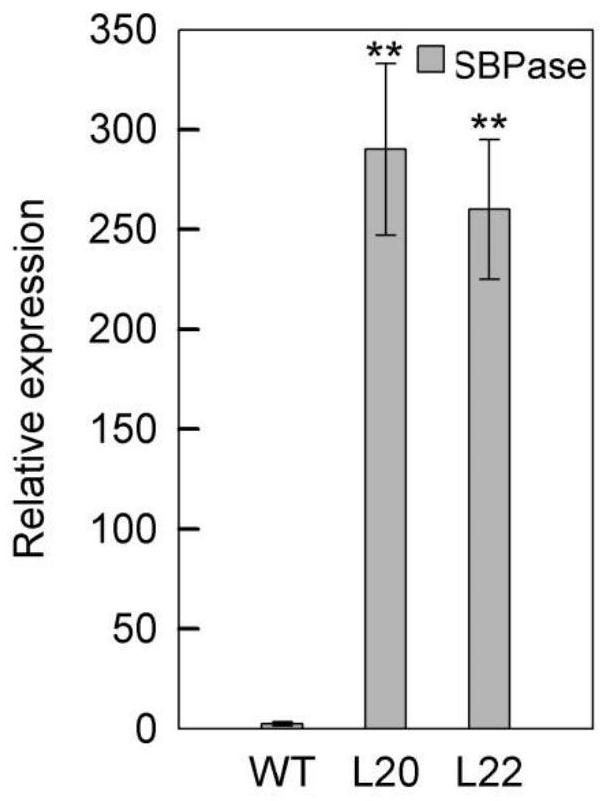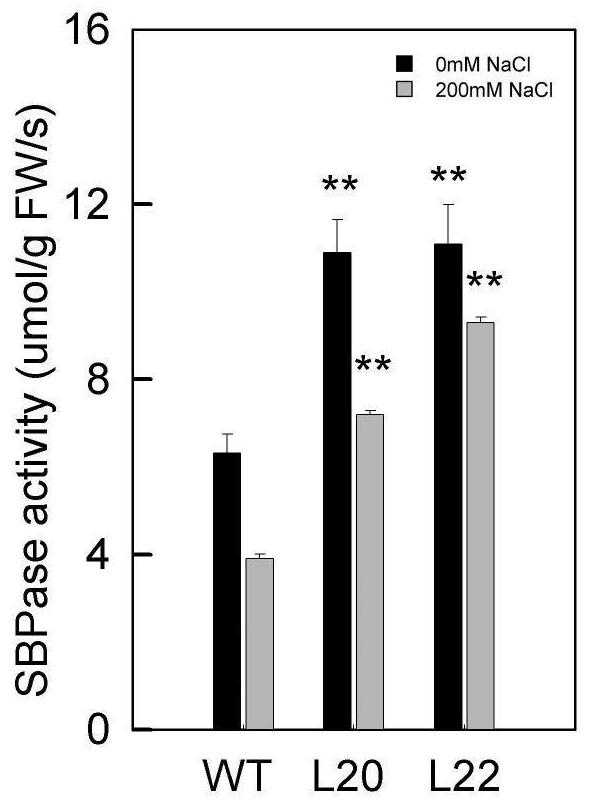Salix matsudana 1, 7-sedoheptulose bisphosphatase as well as encoding gene and application thereof
A technology of sedum heptulose phosphatase and diphosphate, which is applied in the field of genetic engineering, can solve the problems of weakened Calvin cycle renewal ability and reduced photosynthetic activity, and achieves the effect of improved salt tolerance, excellent genetic resources and enzyme resources.
- Summary
- Abstract
- Description
- Claims
- Application Information
AI Technical Summary
Problems solved by technology
Method used
Image
Examples
Embodiment 1
[0034] Embodiment 1: the coding sequence of SmSBPase gene and the acquisition of protein sequence
[0035] Referring to the method of discovering salt-tolerant genes of Salix sativa based on multi-omics determination introduced in Chinese patent CN110484599A, combined with the genome sequence annotation information of Salix sativa and the differentially expressed gene data of salt-tolerant and salt-sensitive Salix sativa plants under salt stress, The SBPase gene of Salix salix was screened out, and its gene coding sequence and protein sequence are shown in SEQ ID NO:1 and SEQ ID NO:2. After Blast comparison with the genome information of red willow (Salixpurpurea) in the phytozome website (https: / / phytozome.jgi.doe.gov / pz / portal.html), it was determined to be Sedoheptulose 1,7-bisphosphate Phosphatase (SBPase) gene, named SmSBPase.
[0036] The above gene coding sequence can be obtained by artificial synthesis and in vitro PCR amplification technology.
Embodiment 2
[0037] Embodiment 2: the acquisition of the recombinant T vector containing SmSBPase gene
[0038] The acquisition of the recombinant T vector comprises the following steps:
[0039] (1) Acquisition of SmSBPase gene: extract RNA from willow leaves, reverse transcribe to synthesize cDNA, use the following primers for PCR amplification, and obtain PCR product 1, which is the SmSBPase cDNA sequence.
[0040] Primer 1: SmSBPase CDS-F
[0041]5'-AACTTGGACATCCAGCTAAAATG-3';
[0042] Primer 2: SmSBPase CDS-R
[0043] 5'-TTAAGCGGCAGCTCCAACAGTAAC-3';
[0044] PCR reaction conditions: pre-denaturation at 95°C for 3 min, 30 sec at 95°C, 38 sec at 56°C, and 50 sec at 72°C, a total of 33 cycles; extension at 72°C for 5 min.
[0045] The PCR product 1 is sequenced, and its nucleotide sequence is shown in SEQ ID NO:3, which consists of 1190 nucleotides and can encode the protein SmSBPase shown in SEQ ID NO:2. Compared with SEQ ID NO:1, SEQ ID NO:3 contains 11 bp 5'-UTR sequence upstream...
Embodiment 3
[0048] Embodiment 3: the acquisition of the recombinant plant expression vector containing SmSBPase gene
[0049] The acquisition of the recombinant plant expression vector comprises the following steps:
[0050] (1) Connection to the plant expression vector Pwm101: Using the pGEM-T-SmSBPase plasmid obtained in Example 2 as a template, PCR amplification was performed using the following primers to obtain PCR product 2.
[0051] Primer 3: Pwm101-SmSBPase-F
[0052] TCGAGCTTTCGCGAGCTCGGTACCATGGAGACTGGTGTAGCATGCTG;
[0053] Primer 4: Pwm101-SmSBPase-R
[0054] GCATGCCTGCAGGTCGACTCTAGATTAAGCGGCAGCTCCAACAGTAAC;
[0055] Both ends of the PCR product 2 were added with 18 nucleotide sequences of the plant expression vector Pwm101, and respectively contained KpnI and XbaI restriction sites. The product sequence is shown in SEQ ID NO:4.
[0056] (2) Acquisition of recombinant plant expression vector: The PCR product 2 obtained in step (1) was recombined with the Pwm101 vector linear...
PUM
 Login to View More
Login to View More Abstract
Description
Claims
Application Information
 Login to View More
Login to View More - R&D
- Intellectual Property
- Life Sciences
- Materials
- Tech Scout
- Unparalleled Data Quality
- Higher Quality Content
- 60% Fewer Hallucinations
Browse by: Latest US Patents, China's latest patents, Technical Efficacy Thesaurus, Application Domain, Technology Topic, Popular Technical Reports.
© 2025 PatSnap. All rights reserved.Legal|Privacy policy|Modern Slavery Act Transparency Statement|Sitemap|About US| Contact US: help@patsnap.com



